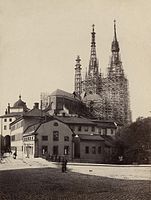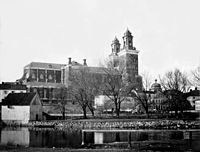Emma Schenson
| Emma Schenson | |
|---|---|
 | |
| Narození | 21. září 1827 Farnost uppsalské katedrály |
| Úmrtí | 17. března 1913 (ve věku 85 let) Farnost uppsalské katedrály |
| Místo pohřbení | Starý uppsalský hřbitov (od 1913; 59°51′22″ s. š., 17°37′39″ v. d.) |
| Povolání | fotografka a malířka |
| Rodiče | Maria Magdalena Schenson |
| Některá data mohou pocházet z datové položky. | |
Emma Sofia Perpetua Schenson (21. září 1827, Katedrála v Uppsale – 17. března 1913, tamtéž) byla švédská fotografka a malířka. Byla jednou z prvních profesionálních fotografek ve Švédsku.[1][2]
Životopis
Schenson, narozená v Uppsale dne 21. září 1827, byla dcerou akademického pokladníka Johna Schensona a školní správcové Marie Magdaleny Hahr. O jejím vzdělání neexistují žádné záznamy, ani o tom, jak se seznámila s fotografií.[1]
V šedesátých letech 19. století otevřela studio v Uppsale, stala se jednou z prvních švédských profesionálních fotografek a první, která v Uppsale založila firmu. Kromě fotografií katedrály v Uppsale vyrobila jako poctu švédskému botanikovi Carlu Linné (1707–1778) sérii asi 20 snímků na albuminovém papíru.[3] V 80. a 90. letech 20. století vytvořila další technicky dokonalou sérii fotografií katedrály, která ukazuje pokrok a výsledky restaurátorských prací. Snímky odhalují nejen její technické dovednosti, ale také její schopnost umístit kameru tak, aby dosáhla architektonicky vynikajících snímků.[1] Ačkoli její negativy zmizely, její fotografie opravované katedrály lze vidět v albu v univerzitní knihovně.[4]
Emma Schenson zemřela v Uppsale dne 17. března 1913. Je připomínána jako jedna z prvních švédských profesionálních fotografek podobně jako Rosalie Sjöman ve Stockholmu, Hilda Sjölin v Malmö a Wilhelmina Lagerholm v Örebro.[2][5]
Galerie
- Fotografie katedrály v Uppsale, 1889
- Katedrála v Uppsale, 1860
- Linnaeusova ložnice, 1864
- Uppsala Mounds, 1895
- Linnaea borealis, kolorováno
- Linnés Hammarby, 1864
Odkazy
Reference
V tomto článku byl použit překlad textu z článku Emma Schenson na anglické Wikipedii.
- ↑ a b c Emma S P Schenson [online]. riksarkivet.se [cit. 2016-05-08]. Dostupné online. (švédsky)
- ↑ a b DAHLMAN, Eva. Women photographers, European experience. [s.l.]: Acta Universitatis Gothoburgensis, 2004. Dostupné online.
- ↑ LINNAEUS, Carolus (1707-1778)--Elias Magnus FRIES (1794-1878) and Emma SCHENSON (1837-1913, photographer). In memoriam Caroli a Linné. [Uppsala]: s.n., [c.1864] [online]. Christues [cit. 2016-05-08]. Dostupné online. (anglicky)
- ↑ Photographs by Emma Schenson [online]. Uppsala Universitetsbibliotek [cit. 2016-05-09]. Dostupné v archivu pořízeném dne 2016-05-12. (švédsky)
- ↑ Dahlman, Eva. Kvinnliga pionjärer osynliga i fotohistorien [online]. Tidskrift för genusvetenskap: University of Gothenburg [cit. 2016-05-11]. Dostupné v archivu pořízeném dne 2018-09-26. (švédsky)
Související články
Externí odkazy
 Obrázky, zvuky či videa k tématu Emma Schenson na Wikimedia Commons
Obrázky, zvuky či videa k tématu Emma Schenson na Wikimedia Commons
Média použitá na této stránce
The hand-coloured photograph shows the initial of the famous Swedish botanist Carl von Linné (1707-78), who called himself Linnaeus. The letter ‘L’ is created by the Linnaea borealis (twinflower), the flower of Linnaeus’ coat of arms.
In 1864 the Swedish photographer Emma Schenson made a series of photographs in memory of the Swedish botanist Carl von Linné (1707-1778), who was known as Linnaeus. Most photographs in the series are taken in his house (now a museum) in Hammarby near Uppsala, Sweden. Linnaeus furnished his home as a kind of personal museum. Almost every detail of the arrangement has a close relationship to his work. In the bedroom the walls were papered with proof copies of drawings by Charles Plumier (French botanist, 1646-1704) and Georg Ehret (botanical artist,1707-1770). The curtain on the bed is printed with a decoration based on his favourite flower, the Linnaea borealis.
"This photograph was taken at the home of botanist Carl von Linné (known as Linnaeus) at Hammarby near Uppsala, Sweden. Linnaeus devised the first consistent binomial classification system for plants, which is still used, in a modified form, today. Schenson's practice as a painter (as well as a photographer) is evident here. She used a painting by Johan Henrik Scheffel (dated 1755, and still in Hammarby) as part of a lively composition. She placed objects of the botanist's daily life, such as his hat, teacup, teapot, and tea caddy, with the painting. His walking stick leans against a chair, as if its owner might return at any moment. Schenson also indicates Linnaeus' place in an ancestral portrait gallery, positioning Scheffel's painting so that the sitter's head appears in line with the two female portraits (his wife and his mother, perhaps) on the wall in the background."
Photograph of Uppsala Cathedral while undergoing repairs in 1889 taken by Emma Schenson, an early female photographer based in Uppsala. The photograph was taken from Gamla torget.
Autor: Emma Schenson, Swedish National Heritage Board from Sweden, Licence: No restrictions
Uppsala Mounds. The three burial mounds, dated to ca. 475-550 AD, are also called the Kings' Mounds. In the background Gamla Uppsala Church (Old Uppsala Church) from the 11th century. Gamla Uppsala is one of several Historical Sites in trust of the Swedish National Heritage Board. Format: Duplicate
Swedish photographer Emma Schenson (1827-1913)












